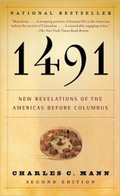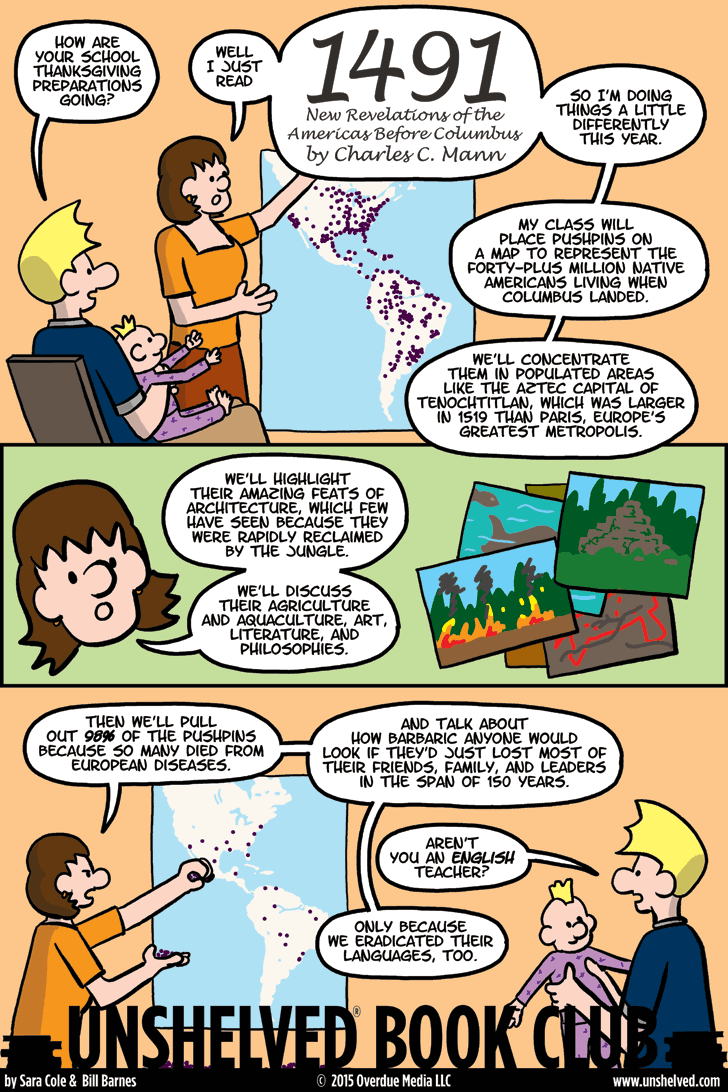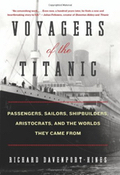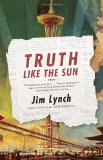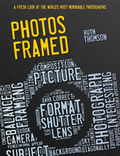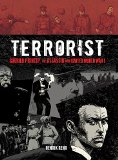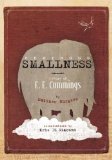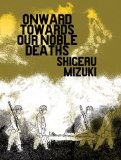Link to this review in the form of a comic strip by saracole tagged history
Link to this review by robert tagged history
As the song says, ”It was sad when that great ship went down,” and Voyagers of the Titanic describes who was on board when it did. Author Davenport-Hines uses surviving letters, eyewitness and survivors’ accounts, newspaper articles, judicial inquiries, and even a U.S. Senate Subcommittee hearing to provide a snapshot of the Titanic’s times and people. He also details the machinations of financier J.P. Morgan and his ineptly run International Mercantile Marine conglomerate, the owners of the White Star Line, then spends equal time describing the remote Lebanese town of Hardin, home of a large immigrant group fleeing oppression and poverty to the U.S. aboard the Titanic. There are also surprising, passenger-by-passenger revelations about those diverted from other vessels to the Titanic because of a coal strike.
Why I picked it up: I’ve read a fair amount about the RMS Titanic. Obliquely, the news that one of Sir John Franklin’s ships had been found made me wonder about other famous wrecks, and I felt it was time to read a new book about the Titanic. That this volume promised to detail the people instead of the technology caught my interest.
Why I finished it: Davenport-Hines delivers. Passengers and crew are described not only en masse with statistics, but also as individuals. Punches are rarely pulled. Plutocrat Jacob Astor isn’t actually called a “slumlord,” but his source of income (his New York tenements) is briefly and richly described. The Titanic’s senior officers all came from commercial sailing backgrounds, and that may have influenced how they operated the Titanic, including its high speed through an ice field. The accommodations are also carefully described. Third Class on the Titanic wasn’t simply an undesirable and uncomfortable open “steerage” space, but separate cabins with lounges, meals with menus, and even teak furniture. Davenport-Hines opens and closes his account with perhaps the most under-presented of all the actors in this high seas tragedy: the iceberg.
Readalikes: The Titanic Disaster Hearings: The Official Transcripts of the 1912 Senate Investigation, edited by Tom Kunz, covers many controversies: Was there a financial motive behind early press reports that a damaged Titanic was heading to port? How did the manager of the White Star Line end up in a lifeboat? Did the Marconi Wireless Company have self-serving motives when negotiating exclusive interviews for their staff with the New York Times? A far less shrill look at the people involved and their behavior permeates Titanic Survivor, White Star Line stewardess Violet Jessop’s memoir (which was often cited in Voyagers of the Titanic). (Jessop also survived the sinking of the Titanic’s sister ship, the Britannic, in 1916, and was on board the third sister ship, the Olympic, when it collided with the HMS Hawke in 1911.) And if you want nuts-and-bolts information about the great ship itself, The RMS Titanic Manual: 1909-1912 Olympic Class by David Hutchins, from auto owner’s guide publisher Haynes, is perfect for you.
Link to this review by darcy tagged historical fiction • literary
Roger Morgan was known as Mr. Seattle because he was at the center of the plans of the 1962 Seattle World’s Fair and the creation of the Space Needle. In 2001, at the age of 70, Morgan decides to make a comeback and run for mayor in the hopes of elevating Seattle to its former glory. Helen Gulanos, a reporter new to town, has accepted the assignment to write about the world’s fair, but sees the opportunity to dig deeper and learn more about Mr. Seattle and his secrets.
Why I picked it up: I’ve had a thing for the Space Needle as long as I can remember and I’m still in love with Lynch’s The Highest Tide.
Why I finished it: I loved the cameos by Elvis and LBJ along with the description of Seattle in the early 60s. The seedy side of the city, including its crooked police department and gambling dens, were some of my favorite parts.
It’s perfect for: Emily, who also has a raunchy sense of humor. I can already hear her laughing out loud when she gets to the part about LBJ adding extra fabric to the crotch of his pants because he feels like he just needs a little more room down there.
Link to this review by flemtastic tagged coming of age • western
Kate’s mother is long dead. During her teens, she and her father were close, relying on each other in the difficult and dusty Wild West, but he was hiding something that got him killed. Kate knows who did it — The Rose Riders — because they always cut a rose into their victims’ foreheads. She also knows that she is going to kill them one by one.
All she has is her father’s advice, drilled into her throughout her childhood: “If anything happens to me, go see my friend Abe.” After visiting Abe’s homestead, Kate, now dressed as a boy, rides for the next town with a pair of disagreeable brothers who are not clear about her quest for vengeance.
Why I picked it up: There aren’t many westerns in my middle school’s library. I took a shot that this would be a good representative of the genre.
Why I finished it: I felt like I had to brush the desert dust off my pants each time I finished a chapter. I also liked that, in the midst of this serious drama about murder and revenge, there is also a little romance. As Kate starts to fall for Jesse, one of her riding partners, but can’t admit it because of her gruff persona, she grieves. One night she is sitting by the fire when Jesse winks at her before going to bed. She spends a while discussing (in her head) whether it was wink or a “squinty flinch,” and chastising herself for getting all in a dither about it.
It’s perfect for: My friend Colin. Much of the action in the book takes place in his hometown, Wickenburg, Arizona. He will love all the descriptions of the local rock formations, desert, sand storms, etc. When I told him about the book, he helped me pronounce the Hassayampa River, and answered why it is called the Upside Down River — it flows underground for ninety-five percent of its 100 mile length.
Link to this review by robert tagged history • art • coffee table book • nonfiction
The twenty-seven photographs selected by Thomson are gloriously presented in large format, and accompanied by meticulous text. This has the production qualities of a coffee table book but it’s written and intended for middle schoolers. As you turn the pages, you see each picture on the entire left side, accompanied by an appropriate quotation about the subject, by the subject, about the photographer, or by the photographer. On the right, you see the name of the picture, the name of the photographer, and the date of the photograph followed by paragraphs about the photograph, the photographer, and “Photo Thoughts,” open-ended questions about each picture. In addition, there are two more small bits of text with each: “Blow Up” asks a question about a particular part of the image and “Zoom In” explains a feature in the picture. The pictures are unevenly divided into four categories (six in “Portrait Photography,” six in “Nature Photography,” four in “Photography as Art,” and eleven in “Documentary Photography”) and appear chronologically within each section. For example the “Portrait Photography” section begins with an 1844 picture of photographic pioneer Louis Daguerre, and ends with an incredibly cute and charming picture of “Meily Mendoza Singing to Her Doll” in 2011.
Why I picked it up: The jacket illustration of an SLR type camera caught my eye, and the subtitle drew me in.
Why I finished it: Ruth Thomson really did select memorable photographs, including old favorites of mine like Gjon Mili’s 1949 portrait of Pablo Picasso (Mili used a long-term exposure to capture not only Picasso, but also the entirety of a drawing Picasso made with a light) and astronaut William Anders’ 1968 “Earthrise.” She also selected pictures I’d not seen before, such as Sebastião Salgado’s 1986 picture of hundreds of workers at an open pit gold mine, hauling bags of dirt and ore on their backs up rows of ladders. David Hockney’s “Pearblossom Highway #2” captures the arid expanses and larger-than-life significance of signs and (alas) roadside trash along California’s long state routes through rural and desert areas. (I’ve ridden bicycles on these sorts of roads.) Thomson concentrates on the image and image makers, and although technical matters occasionally arise, leaves the text mostly free of things like shutter speeds, camera apertures, and film types.
Readalikes: Go: A Kidd’s Guide to Graphic Design by Chip Kidd, which shows well-designed images, asks questions about the impressions they make, and is geared for younger readers. If the images and descriptions in Photos Framed motivate you to brush the dust off your own picture taking gear, you might be interested in Digital Photography FAQs by Jeff Wignall. Not only does he treat technical questions about exposure time, metering, and depth of field with specificity, but he also gives great tips about framing and composition. To give you an idea of how ruthless Thomson’s winnowing of images had to be to get to her final twenty-seven, here’s a book built around an image that didn’t make it: Little Rock Girl 1957: How a Photograph Changed the Fight for Integration by Shelley Tougas, written for the same age range, but a good read for anyone.
Link to this review by sarahhunt tagged nonfiction
The gripping stories of how each of the ten deadliest U.S. fires started, raged and destroyed, and were defeated, from city-destroying fires in the early years of the country to a wildfire that tore across San Diego County in 2007.
Why I picked it up: It sounded like a great combination of history and disaster drama.
Why I finished it: Each chapter was full of amazing details that made me feel like I could see the fires happening in front of my eyes: the fire chief electrocuted by the live power lines strung next to the burning buildings in Baltimore in 1904, the heat of the 1835 fire in New York City melting copper roofs, and the little girl who sank without a trace into the East River because of the rotted life preservers aboard the doomed steamship General Slocum.
Readalikes: Bomb by Steve Sheinkin also uses a lot of primary historical source material and an eye for the poignant to weave a tale (about the atom bomb) that you also won’t be able to put down.
Link to this review by flemtastic tagged graphic novel • history
A serious, scholarly graphic novel that explores the bungled yet ultimately successful plot by a small cabal of anarchistic teens and college students to assassinate Archduke Franz Ferdinand, the spark that began WWI. Causes and motivations are examined from the perspectives of Gavrilo Princip (the assassin) and his collaborators, as well as from the Archduke’s Austria-Hungary dynasty. Court transcripts from the trial that followed are included, as are quotes from Otto von Bismarck (German Chancellor) and Sir Edward Grey (British Foreign Secretary).
Rehr’s drawings are realistic, intricate, and remind me of those in Selznick’s The Invention of Hugo Cabret. Some resemble historical photographs or news articles. The climactic scene where Princip shoots Archduke Ferdinand is rendered from ten different angles to give a real bite to the shocking nature of the event and how it impacted all who witnessed or heard about it. A great way to introduce readers not familiar with the events of June 28th, 1914 to a very important historical event.
Why I picked it up: I had been hearing a lot about the assassination of Archduke Franz Ferdinand because of the event’s 100-year anniversary (I especially liked this NPR story), so picking this book up and learning more was an easy call.
Why I finished it: This is an entertaining graphic novel. Rehr plays with the timeline a little bit — he starts with the shooting, then goes back to Princip’s and Ferdinand’s births to begin again before moving toward the trials and eventual ends of all the major players. My major realization after reading this book was how easy it would have been for Ferdinand to avoid assassination. He could have kept his route secret, not stopped to greet his subjects (coincidentally near the sandwich shop where Princip was eating a sandwich, disappointed), and listened to his security forces.
Readalikes: Larry Gonick’s History of the World Comic Book Volumes 1-7. While Terrorist isn’t humorous, it is every bit as entertaining.
Link to this review by dawnrutherford tagged picture book • biography
Edward Estlin Cummings grew up in Cambridge in a household full of relatives, servants and pets. When he began spouting poetry at three, his mother encouraged him by writing his observations in a little book. He attended Harvard, and at graduation gave an inspiring speech about artists who were revolutionizing the way people perceived the world and how he was determined to be one himself. During WWI he volunteered for the Ambulance Corps but was mistaken for a spy and imprisoned. His memoir of this incident, The Enormous Room, was his first published book. From there he went on to live the life of a successful poet and painter.
Why I picked it up: E.E. Cummings has been my favorite poet for many years now. The collection of his work Complete Poems 1904-1962 is one of my all time favorite presents — it was sent to me by my dad as part of a college care package. I find something to surprise and delight every time I open it, but really didn’t know anything about Cummings himself.
Why I finished it: It is always hard to tell how much picture books soften up harsh realities, but from this I got a clear sense that Cummings never had to keep a day job to support himself thanks to his reasonably wealthy family. This is such a different story from the lives of so many writers that it really struck me how much more wonderful the world would be if people could think big thoughts about art and imagination rather than worrying about survival.
Plus it’s beautiful. Each page is a collage of words and visual elements that work in the manner of a Cummings poem. Letters fall from his mouth during graduation, and the more he writes, the more letters make up parts of the background colors of the pages.
Readalikes: Anyone who appreciates this delightful blending of art and poetry will also like Douglas Florian’s delightful poems and paintings including UnBEElievables, insectlopedia, in the swim, and on the wing.
Link to this review by wally tagged history • graphic novel • biography
First published in Japan in 1973, this fictionalized memoir about serving in the Japanese army in the South Pacific during World War II focuses on a platoon of Japanese soldiers who had to fend off malaria, boredom, and starvation. They often received incomprehensible orders from their officers, like when they were told to cut off a dying soldier’s little finger, while bullets were still flying by, to prove he died in battle.
Why I picked it up: I just finished reading Mizuki’s pre-WWII history of Japan, Showa, and wanted to read about what came next.
Why I finished it: I loved the rhythm of this book. There are many typical, idyllic scenes of the South Pacific that show the dull, easy, everyday lives of soldiers. Events turn tragic quickly and unexpectedly, and not just in battle. Once, the sergeant orders his men to go pig hunting, and, after that fails, to fish with grenades. When one starving man tries to swallow a whole fish, he chokes and dies. In a later scene, a doctor-soldier confronts his commanding officer about the suicide missions, questioning why other countries allow their soldiers to be captured; getting nowhere, he commits suicide alone.
It’s perfect for: Scott, who would enjoy the anti-war themes even as the story shows the soldiers in a sympathetic light. He would particularly appreciate the increasingly blind orders of the desperate officers stationed far from the men, who send them to their “noble” deaths on suicide missions or, if they survive, demand that they kill themselves to retain honor for themselves and their families.
